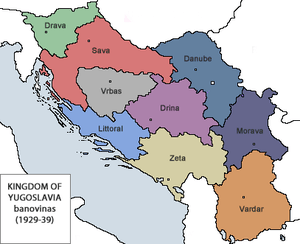Drina Banovina
| Drina Banovina Drinska banovina Дринска бановина | |||||
| Banovina of the Kingdom of Yugoslavia | |||||
| |||||
 | |||||
| Capital | Sarajevo | ||||
| History | |||||
| • | Established | 1929 | |||
| • | Disestablished | 1941 | |||
| Today part of | Bosnia and Herzegovina, Serbia | ||||


The Drina Banovina or Drina Banate (Serbian and Bosnian: Дринска бановина/Drinska banovina) was a province (banovina) of the Kingdom of Yugoslavia between 1929 and 1941. Its capital was Sarajevo and it included portions of present-day Bosnia and Herzegovina and Serbia. It was named after the Drina River and, like all Yugoslav banovinas, was intentionally not based on ethnic boundaries.

Borders
According to the 1931 Constitution of the Kingdom of Yugoslavia,
- The Drina Banovina is bounded on the west, as far as the Sava, by the boundaries ... of the Littoral and Vrbas Banovinas, then on the north by the river Sava to where it is joined by the Kolubara. From this confluence and up to the eastern boundary of the Maritime Banovina (eastern boundary of the district of Konjic, hill 2058 in the Treskavica mountains) the boundary of the Drina Banovina follows the eastern boundaries of the districts of Posava (capital, Obrenovac), Tamnava, Kolubara (capital, Mionica) and Požega, including the district of Ljubić. It then follows the eastern boundaries of the districts of Trnava and Dragačevo, then the southern and western boundaries of the district of Moravica, continuing along the southern boundaries of the districts of Arilje, Zlatibor, Višegrad, Čajniče, Rogatica, and Sarajevo.
History
In 1941, the World War II Axis Powers occupied the Drina Banovina and the province was abolished and divided between the Independent State of Croatia and German-occupied Serbia. Following World War II, the region was divided between Bosnia and Herzegovina and Serbia within a federal Socialist Yugoslavia.
See also
| Wikimedia Commons has media related to Drina Banovina. |
Coordinates: 43°52′00″N 18°25′00″E / 43.8667°N 18.4167°E